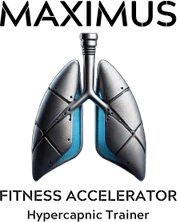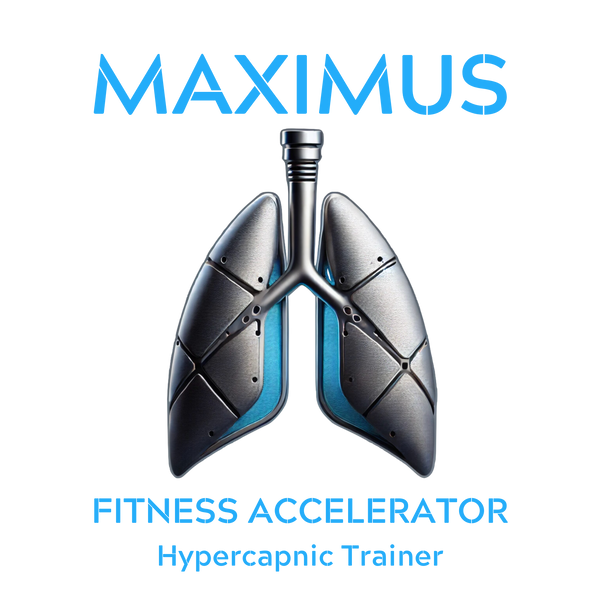
MAXIMIZE YOUR VO2 MAX & MORE - USING MAXIMUS - Hypercapnic Training
Share
Meet Hypercapnic Training
Why MAXIMUS Is Leading It?
Athletes and coaches are always hunting for small, repeatable edges. One of the most promising — and under-explored — is hypercapnic training: short, controlled bouts that intentionally raise CO₂ exposure during breathing to provoke targeted physiological adaptations. The MAXIMUS device from TrainMaximus brings hypercapnic training out of niche labs and into practical, everyday workouts with a feature set designed to drive measurable improvements in lung function, efficiency, and performance metrics like VO₂max and lactate threshold.
What hypercapnic training does?
Hypercapnia means elevated CO₂. When CO₂ rises transiently during training, the body responds in ways that matter for performance: altered ventilatory control, better tolerance of CO₂ (and the associated acidosis), and changes in breathing muscle workload. These responses can reduce wasted ventilation, improve breathing economy, and shift metabolic thresholds — all of which help an athlete stay faster, longer. Recent translational and applied research into respiratory-muscle training and controlled hypercapnic exposures suggests these respiratory adaptations can support improvements in VO₂peak, ventilatory efficiency, and lactate handling.
Why device design matters: dual airflow resistance (DART)
Not all breathing trainers are created equal. MAXIMUS differentiates itself with Dual Airflow Resistance Technology (DART) — the ability to add resistance both on inhalation and exhalation in a controlled, tunable way. That’s important for two reasons:
-
Balanced respiratory load — Most inexpensive trainers load only inspiration (or only expiration). The respiratory system is bi-directional: inspiratory muscles (diaphragm, external intercostals) and expiratory muscles (abdominals, internal intercostals) both contribute to breathing under load. DART lets you strengthen both sides of the pump, producing more balanced, sport-relevant adaptations. MAXIMUS markets this as a core tech advantage.
-
Modulating hypercapnia safely — Exhalation resistance slows CO₂ washout. By tuning exhalation resistance together with inspiratory load, MAXIMUS creates controlled hypercapnic actuation — enough CO₂ to elicit training signals, without forcing unsafe levels. Put simply: you can dial the CO₂ stimulus and the muscular challenge independently, which is how practical hypercapnic training is made safe and repeatable.
How that translates into performance gains
Here are the pathways through which a dual-resistance hypercapnic device like MAXIMUS can help an athlete:
-
Stronger respiratory muscles → less competition for blood flow
Breathing during maximal exercise consumes a nontrivial share of cardiac output. Strengthening inspiratory and expiratory muscles reduces the relative work of breathing and the oxygen cost of ventilation, freeing more oxygen and blood flow for locomotor muscles. Studies show respiratory muscle strength correlates with VO₂max and exercise tolerance.
-
Improved ventilatory efficiency
Training that targets ventilatory control can reduce unnecessary ventilation (minute ventilation) at submaximal workloads, improving the ratio of ventilation to CO₂ elimination (V̇E/V̇CO₂). That makes steady-state work less physiologically costly and delays the point where ventilation spikes and performance drops. Research into inspiratory muscle training has documented improvements in ventilatory responses and, in some protocols, VO₂peak.
-
Higher lactate threshold & better lactate clearance
By shifting the balance between aerobic and anaerobic energy systems and by improving breathing economy, athletes often experience a higher lactate threshold — meaning they can sustain a faster pace before lactate accumulates quickly. TrainMaximus emphasizes lactate clearance and threshold increases as key outcomes of MAXIMUS training.
-
VO₂max gains (via multiple paths)
VO₂max improvements can come from increased central delivery (cardiac adaptations), peripheral adaptations (mitochondrial density), and improved pulmonary/ventilatory efficiency. Respiratory muscle training is one lever among several; evidence across studies shows RMT protocols can improve VO₂peak in trained populations when added to normal training. MAXIMUS frames its hypercapnic approach as a way to accelerate those respiratory and metabolic adaptations.
Practical use — how athletes train with MAXIMUS
MAXIMUS is intended to be used both as a stand-alone breathing workout and integrated into regular exercise sessions. Because DART lets you control inspiratory and expiratory resistance, athletes can:
-
Do dedicated respiratory strength sessions (like “weightlifting for the lungs”).
-
Add breath-resistance intervals to warm-ups or cooldowns.
-
Use moderated exhalation resistance during interval work to produce transient hypercapnia without drastically changing training intensity.
TrainMaximus provides a progression (including a Pro-Trainer version for advanced users) so athletes can ramp resistance and CO₂ stimulus safely over weeks. The product pages and help center describe the DART system and recommended use.
Evidence caveats — be realistic
The physiological rationale and several studies support respiratory muscle training and controlled hypercapnic/hypoxic exposures as performance tools. But the literature is heterogeneous: effect sizes vary by protocol, population, and how VO₂max and lactate thresholds are measured. Some benefits are clearer for ventilatory efficiency and breathing strength than for large, consistent VO₂max changes across all athletes. In short: MAXIMUS is a promising and well-designed tool, but best results come when it’s integrated into a thoughtful training plan, not used in isolation.
Bottom line — why MAXIMUS stands out
MAXIMUS’ selling point is not hype — it’s engineered control. By combining dual airflow resistance (DART) with a progression model and clear training protocols, the device lets athletes safely tap into hypercapnic stimuli while simultaneously strengthening both inhalation and exhalation mechanics. That combination targets the respiratory system more comprehensively than single-direction trainers, making MAXIMUS a strong candidate for athletes who want to squeeze extra efficiency, higher lactate threshold, and measurable respiratory gains out of their training.
